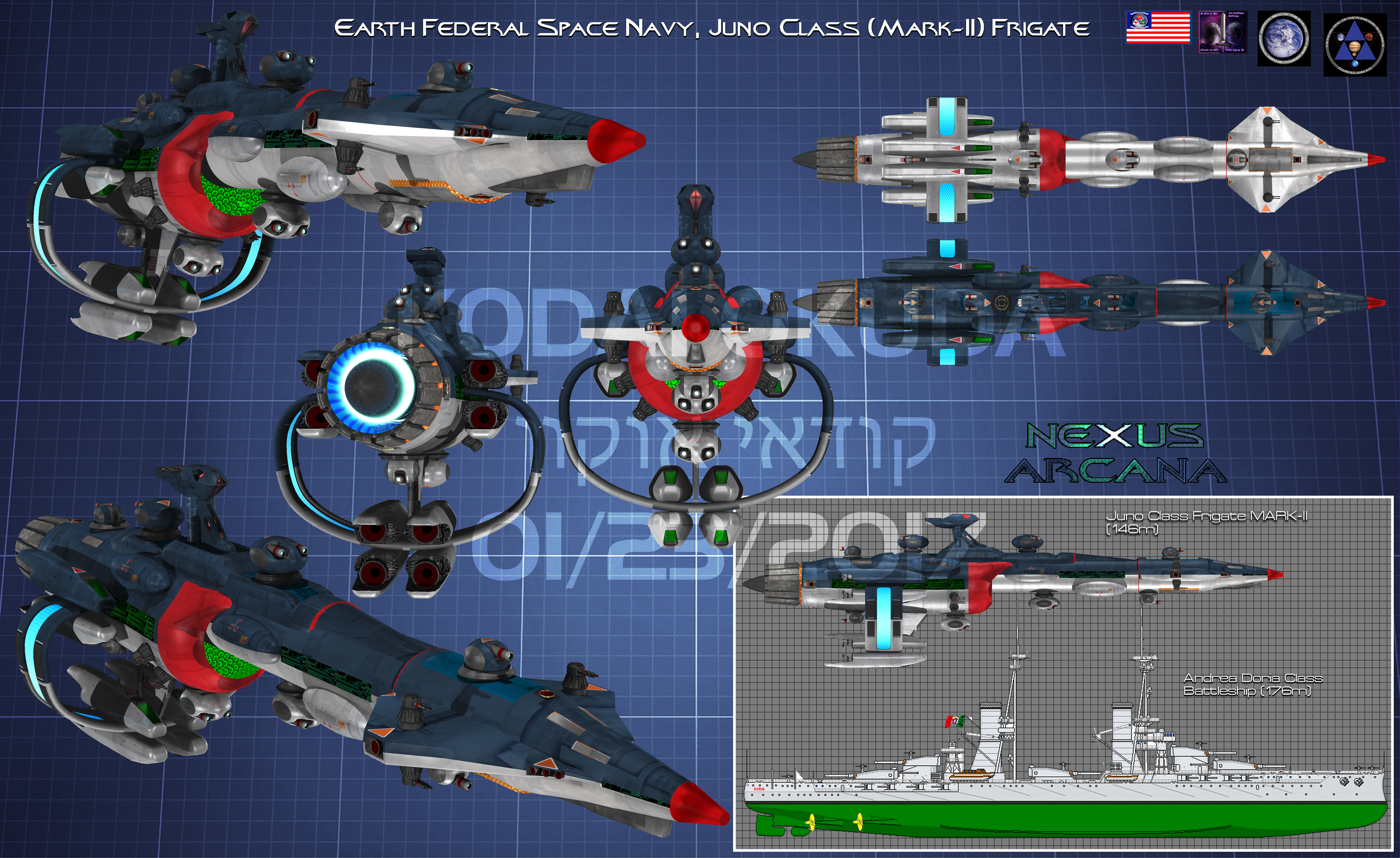 |
||
 |
||

SPECIFICATIONS
GOVERNMENT: United States Space Navy, LaGrange Space Navy, Earth Federal Space Navy, Planetary Alliance
TYPE: Frigate
MODEL: Juno Mark-II class
DATE INTRODUCED: 2178 AD
LENGTH: 480 feet
WIDTH: 110 feet
HEIGHT: 140 feet
MATERIAL: Composite Alloy
POWER PLANT: 2x Rokwheel RNR-7500A nuclear reactor
OUTPUT: 7500 megawatts each (15,000 megawatts total)
ARMOR TYPE: Crystal Composite
ARMOR THICKNESS: .5 inches (12.7mm)
DISPLACEMENT: 3500 tons
CREW: 63 (3 Operator/pilot, 4 Officers, 2 Medical, 22 Gunners, 3 Technician, 3 Electrician, 6 Engineers, 20 Flight)
PROPULSION
PRIMARY:
1x Rocketdyne RFT-1776 Fusion Thruster
SPEED: 77,400 mph
AUXILLIARY:
4x Rocketdyne FT-493.5 Fusion Thrusters
SPEED: 21,500 mph each
FASTER THAN LIGHT DRIVE:
1x Terran Technologies TTID-T3-350R, Type-3 Intersection Drive (Ring)
SPEED: .18 light years per hour
WEAPONS:
PRIMARY (OFFENSIVE):
4x Norking LC-1602 160-megawatt dual laser cannon turrets; Effective Range: 800 miles; Power Requirement: 160-megawatts; ROF: up to 6 dual blasts per minute.
SECONDARY (OFFENSIVE):
4x Norking LC-801 80-megawatt laser cannon turrets; Effective Range: 800 miles; Power Requirement: 80-megawatts; ROF: up to 6 blasts per minute.
SECONDARY (OFFENSIVE):
6x Bohing STL-02; Missile Type: MHST-01 2000-pound SMART-guided space torpedo with 119.5-Kiloton yield nuclear warhead; Effective Range: 27 miles; Payload: 10 space torpedoes each; ROF: 1 torpedo each launcher every 2 seconds (up to 30 per minute).
PRIMARY (DEFENSIVE):
8x Norking LC-202 dual 20-megawatt laser cannon turrets; Effective Range: 200 miles; Power Requirement: 40-megawatts; ROF: up to 12 blasts per minute.
ELECTRONICS:
1x Microwave radio Communications array with a 10 AU range.
1x Laser Communications array with a 1000 AU range.
1x Super Luminal Velocity communications array with a 1 light year range
1x RADAR sensor array with a 200,000-mile range.
1x Passive EMS sensor array with a 500,000-mile range.
1x Active EMS Sensor array with a range of 100,000 miles.
1x Super Luminal Velocity sensor array with a 1 parsec range.
1x Gravitational Control/Antigravity unit Effect: provides artificial lift,g-force compensation and enhanced maneuverability.
HANGAR BAYS:
1x 1200-yd3 this general purpose hangar holds up to twenty EA-59A Jet Jaegers.
DEFENSE SYSTEMS:
6x Warptron DFG-300 300-megawatt Graviton Level-01 deflector field generators; RANGE: 300 feet; Effect: Each generator has an output of 54,000 gigjoules (54 terajoules), and a regeneration rate of 5400 gigajoules (5.4 TJ) per 10 seconds.
Description/Overview:
The 1st Interplanetary War of the 2170s pushed the original Mark-I Juno class ships to their limits. By 2177, the combined LaGrange-USSN-EFR alliance space fleet command decided on a massive upgrade of the existing fleet of space warships in their fleets to combat the remnants of the Solar Empire and what they saw as the rising threat of the Jovian Defense Forces in the Outer Sphere of the Sol system. The effort to push the upgrade of all EFR ships was led Admiral George Bosch. He called for the immediate development of upgrades using FTL drives for the existing fleet of EFR warships. He knew that the fleet of frigate sized vessels would permit the EFSN space fleet to dominate the Inner Sphere of Sol if they had adequate FTL capability.
The Juno Mark-II class was one of the first refits to be put into action. The whole fleet of Juno class frigates were pulled from service when the 1st Interplanetary War ended in late 2177, and the first squadrons of refit ships saw some action in mid-2178. The bulk of the Juno fleet completed their refits in 2178 and 2179, so by 2180 the entire force of Juno class frigates were now Mark-IIs. The major difference between the Juno class and the Juno Mark-II is the addition of the Type-3 Intersection-Drive Ring and the required communication and sensor suits; four additional fusion thrusters; the lengthening of the main hull to accommodate an additional Tesla-Shauberger Gravitational control unit for the Intersection-Drive, and the addition of deflector field generators in place of the old nuclear dampening units. A fourth dual-80-megawatt laser cannon turret was added to the ventral side of the ship for additional firepower.
The Juno Mark-II remained in service with the EFR, the LaGrange forces, and eventually became the main space frigate of the fledgling Planetary Alliance fleet during the Ceres Conflict of 2183-2184. These craft served as the Solar Guard main space frigate throughout the late 2180s and into the early 2190s just prior to the outbreak of the 2nd Interplanetary War. After that, a Mark-III was introduced.